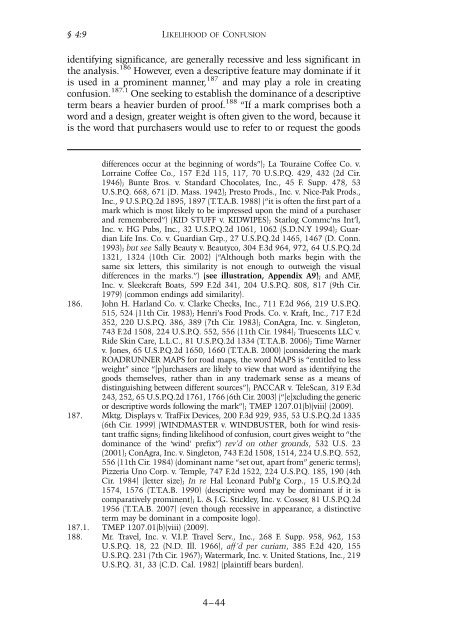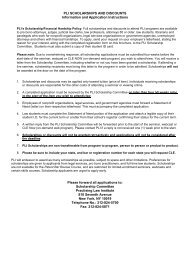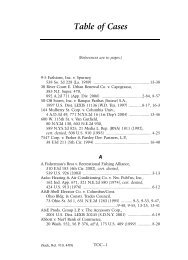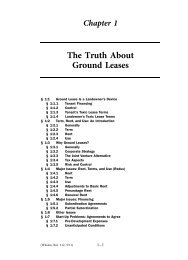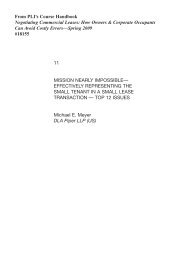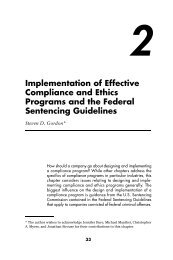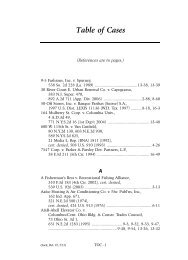View a Sample Chapter
View a Sample Chapter
View a Sample Chapter
Create successful ePaper yourself
Turn your PDF publications into a flip-book with our unique Google optimized e-Paper software.
§ 4:9 LIKELIHOOD OF CONFUSIONidentifying significance, are generally recessive and less significant inthe analysis. 186 However, even a descriptive feature may dominate if itis used in a prominent manner, 187 and may play a role in creatingconfusion. 187.1 One seeking to establish the dominance of a descriptiveterm bears a heavier burden of proof. 188 “If a mark comprises both aword and a design, greater weight is often given to the word, because itis the word that purchasers would use to refer to or request the goodsdifferences occur at the beginning of words”); La Touraine Coffee Co. v.Lorraine Coffee Co., 157 F.2d 115, 117, 70 U.S.P.Q. 429, 432 (2d Cir.1946); Bunte Bros. v. Standard Chocolates, Inc., 45 F. Supp. 478, 53U.S.P.Q. 668, 671 (D. Mass. 1942); Presto Prods., Inc. v. Nice-Pak Prods.,Inc., 9 U.S.P.Q.2d 1895, 1897 (T.T.A.B. 1988) (“it is often the first part of amark which is most likely to be impressed upon the mind of a purchaserand remembered”) (KID STUFF v. KIDWIPES); Starlog Commc’ns Int’l,Inc. v. HG Pubs, Inc., 32 U.S.P.Q.2d 1061, 1062 (S.D.N.Y 1994); GuardianLife Ins. Co. v. Guardian Grp., 27 U.S.P.Q.2d 1465, 1467 (D. Conn.1993); but see Sally Beauty v. Beautyco, 304 F.3d 964, 972, 64 U.S.P.Q.2d1321, 1324 (10th Cir. 2002) (“Although both marks begin with thesame six letters, this similarity is not enough to outweigh the visualdifferences in the marks.”) (see illustration, Appendix A9); and AMF,Inc. v. Sleekcraft Boats, 599 F.2d 341, 204 U.S.P.Q. 808, 817 (9th Cir.1979) (common endings add similarity).186. John H. Harland Co. v. Clarke Checks, Inc., 711 F.2d 966, 219 U.S.P.Q.515, 524 (11th Cir. 1983); Henri’s Food Prods. Co. v. Kraft, Inc., 717 F.2d352, 220 U.S.P.Q. 386, 389 (7th Cir. 1983); ConAgra, Inc. v. Singleton,743 F.2d 1508, 224 U.S.P.Q. 552, 556 (11th Cir. 1984); Truescents LLC v.Ride Skin Care, L.L.C., 81 U.S.P.Q.2d 1334 (T.T.A.B. 2006); Time Warnerv. Jones, 65 U.S.P.Q.2d 1650, 1660 (T.T.A.B. 2000) (considering the markROADRUNNER MAPS for road maps, the word MAPS is “entitled to lessweight” since “[p]urchasers are likely to view that word as identifying thegoods themselves, rather than in any trademark sense as a means ofdistinguishing between different sources”); PACCAR v. TeleScan, 319 F.3d243, 252, 65 U.S.P.Q.2d 1761, 1766 (6th Cir. 2003) (“[e]xcluding the genericor descriptive words following the mark”); TMEP 1207.01(b)(viii) (2009).187. Mktg. Displays v. TrafFix Devices, 200 F.3d 929, 935, 53 U.S.P.Q.2d 1335(6th Cir. 1999) (WINDMASTER v. WINDBUSTER, both for wind resistanttraffic signs; finding likelihood of confusion, court gives weight to “thedominance of the ‘wind’ prefix”) rev’d on other grounds, 532 U.S. 23(2001); ConAgra, Inc. v. Singleton, 743 F.2d 1508, 1514, 224 U.S.P.Q. 552,556 (11th Cir. 1984) (dominant name “set out, apart from” generic terms);Pizzeria Uno Corp. v. Temple, 747 F.2d 1522, 224 U.S.P.Q. 185, 190 (4thCir. 1984) (letter size); In re Hal Leonard Publ’g Corp., 15 U.S.P.Q.2d1574, 1576 (T.T.A.B. 1990) (descriptive word may be dominant if it iscomparatively prominent); L. & J.G. Stickley, Inc. v. Cosser, 81 U.S.P.Q.2d1956 (T.T.A.B. 2007) (even though recessive in appearance, a distinctiveterm may be dominant in a composite logo).187.1. TMEP 1207.01(b)(viii) (2009).188. Mr. Travel, Inc. v. V.I.P. Travel Serv., Inc., 268 F. Supp. 958, 962, 153U.S.P.Q. 18, 22 (N.D. Ill. 1966), aff’d per curiam, 385 F.2d 420, 155U.S.P.Q. 231 (7th Cir. 1967); Watermark, Inc. v. United Stations, Inc., 219U.S.P.Q. 31, 33 (C.D. Cal. 1982) (plaintiff bears burden).4–44


